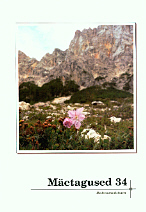Halltõvega seotud tõrjevõtted ja nende liigitamine
Practical Magic Connected with Ague (Malaria) and its Categories
Author(s): Piret PaalSubject(s): Customs / Folklore
Published by: Eesti Kirjandusmuuseum
Keywords: archive texts; ague; fuzzy categories; classification; malaria; legend; folk tale; folk medicine
Summary/Abstract: This article is a part of my MA thesis entitled Estonian and Finnish-Karelian Ague Tradition - Analysed on the Basis of Archive Texts (University of Tartu, Department of Estonian and Comparative Folklore, 2004). In this article I will explore the aspects of practical magic connected with ague in Estonia and discuss the problem of classification in folk medicine research. Ague treatment used various archaic techniques based on analogy and contact magic. I have divided these techniques into three categories, characterised by inaccuracy, flexibility, and unfixed boundaries. Many recent studies generally consider the so-called fuzzy categories the most suitable for describing human reasoning. The first group consists of magic rituals, in which the methods of treatment are based on imagery related to ague. Along with rituals, the texts also describe the use of rational methods of treatment. The herbs to be consumed for this purpose were predominantly shaky and had a pungent smell. Animal products used for this purpose include the flesh, blood, and excrements of animals that were believed to have magical powers. Verbal spells used during a healing ritual form the third category. The healing rituals described in stories may be either common folk medicine practices or rituals characteristic of narrative tradition. Stereotypical methods of treatment include confining the disease in a tobacco pouch or taking it to a nearby farm on a horse. Although such descriptions are realistic in nature, they are fixed in certain types of narratives and used in the interest of a specific narrative. Thus, one can call them fictive rituals. The initial function of ague legends has been sharing knowledge with a certain social group. The stories were a way of acquiring basic knowledge about the causes and the symptoms of the disease, also providing guidance on how to avoid and defeat the disease. All the records of tradition reflect ways of defeating the disease, which are typical of folk medicine practices. This psychological process of delivering relevant information by means of legend is typical of agrarian tradition, and marks the possibility of defeating a disease of unknown origin by using easily available methods.
Journal: Mäetagused. Hüperajakiri
- Issue Year: 2006
- Issue No: 34
- Page Range: 111-132
- Page Count: 22
- Language: Estonian

